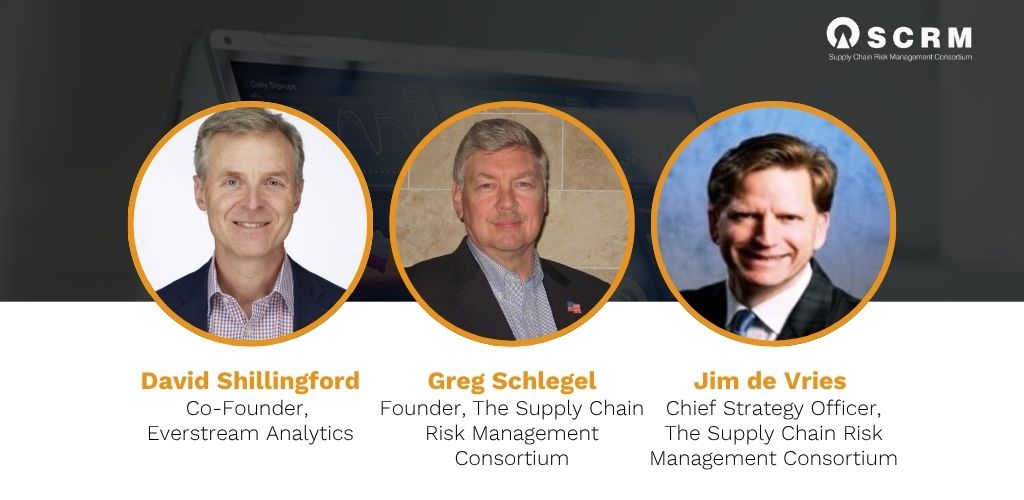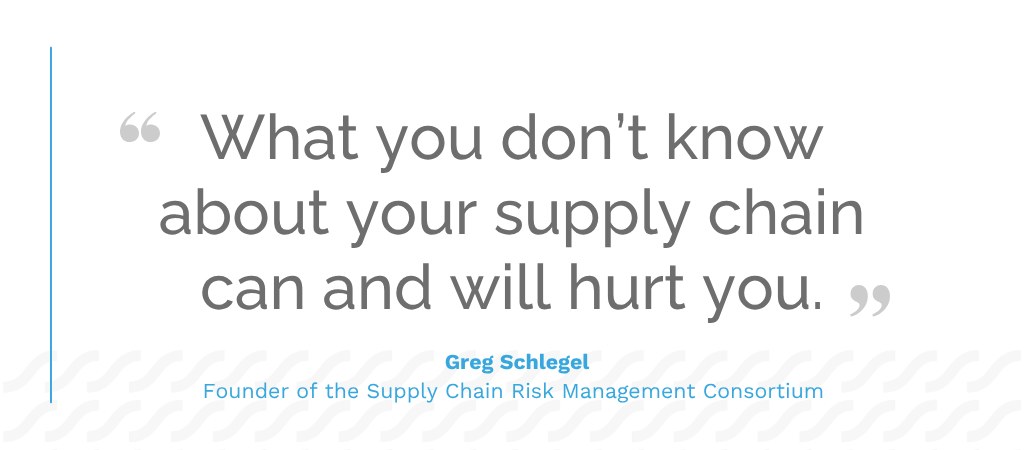
Supply chain disruptions are a daily reality. While the importance of managing supply chain risk is widely acknowledged, many organizations struggle to translate their risk management efforts into tangible value.
How do you build a business case for investing in supply chain risk management (SCRM)? What does a successful program look like, and how can you measure its return on investment?
To answer these critical questions, we’ve distilled the key insights from a recent webinar, “How to Realize the Value of Investing in Supply Chain Risk Management Solutions,” hosted by Everstream Analytics in partnership with the Supply Chain Risk Management Consortium.
This Q&A-style blog post features insights from a panel of seasoned experts:
- David Shillingford, Co-founder of Everstream Analytics
- Greg Schlegel, Founder of the Supply Chain Risk Management Consortium
- Jim de Vries, Chief Strategy Officer at the Supply Chain Risk Management Consortium
Here’s what they had to say about turning risk into a competitive advantage.
Understanding Supply Chain Risk Management Value
What is the biggest challenge companies face when trying to get value from their SCRM efforts?
David notes that the primary challenge is bridging the gap between the daily discussions about supply chain disruptions and the internal conversations with CFOs about investment.
He explains:
“On one hand every day there are examples, discussions about supply chain risk and supply chain disruptions and the importance of managing risk and supply chains. But then there is a gap between that and the discussion within a company with the CFO or whoever it is that’s signing off on an investment.”
While everyone sees the need for resilience, the key is to move beyond the what and how of SCRM and focus on the why – the tangible value it delivers
Building Visibility and Maturity
What is the first step to building a successful SCRM program?
The consensus is clear: visibility.
Jim explains that most companies are at a low level of supply chain maturity, meaning they can barely see what’s happening in their own network.
He describes a common “one, two, three step” pattern where companies advance to a stage 3 of maturity (referencing Gartner’s 5-stage model) and then regresses because leadership doesn’t see the return when attempting move from stage 3 to 4.
Greg reinforces this, stating, “What you don’t know about your supply chain can and will hurt you.”
Visibility is the foundational second stage in the Consortium’s five-stage maturity model, providing the insight needed to act proactively.

Do you need to have a fully mature supply chain to get value from SCRM?
No. David debunks this myth, stating that you can gain value from SCRM from day one, even with limited visibility.
He argues that companies should not wait to perfect their supply chain processes before investing in risk management. The two should evolve together, with SCRM providing immediate benefits by leveraging the visibility you have today.
“I think a mistake that I often hear is the assumption that – ‘I’ve got to get to a certain level of supply chain maturity before I can reap a return around supply chain risk management.’ And that’s incorrect. The two should evolve in parallel.”
Developing Agility and Resilience
How does resilience create value, and isn’t it just about costly redundancy?
This is a critical misconception. David clarifies that while redundancy (e.g., extra inventory, more suppliers) is a part of resilience, it is not the whole story. A more powerful and value-creating component of resilience is agility.
“The easiest way to think about agility is speed versus competition. If you can move faster than the competition to get that capacity, not only is your time to recover going to be faster, you will gain market share or you have the opportunity to gain market share.”
As Jim puts it, “Resiliency isn’t about surviving disruptions. It’s about converting disruptions into differentiation. You’re going to move from the mindset of surviving disruptions into thriving through disruptions.”
What role does trust play in building an agile and resilient supply chain?
Trust is a massive, often overlooked, accelerator.
Greg notes that trust translates to a significant strategic advantage.
“When trust is present between you and your partners, activities between the entities are accelerated and costs decrease.”
Building trust with both customers and suppliers, even to the point of being transparent about challenges, can lead to collaborative problem-solving and a more resilient network.
This fosters a dynamic where you can become both the “preferred customer” and the “preferred supplier”.




